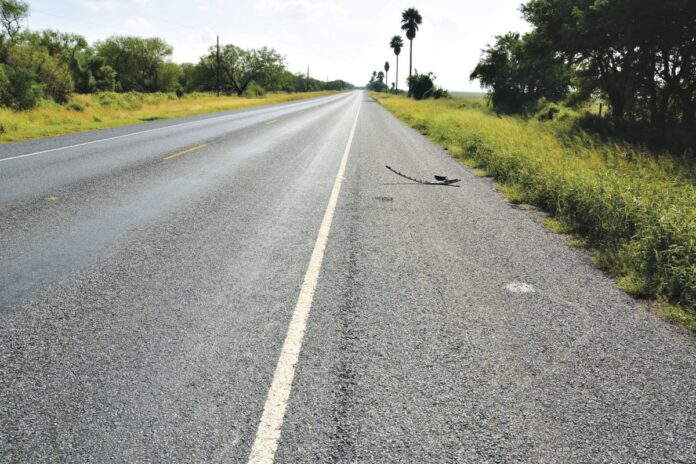SAN MANUEL — On a sunny fall morning on the cusp of Thanksgiving Day, a car races westward on State Highway 186 in Hidalgo County just past the Willacy County line, headed toward U.S. 281.
To the south, open farm fields dominate this landscape, with a thin strip of trees and shrubs separating the cropland and the highway. But on the northern side of the highway, which has a posted speed limit of 75 mph, lies the dense thorn scrub that makes up much of the Lower Rio Grande National Wildlife Refuge.
Suddenly a dark shape hurtles out from the tree line south of the highway heading toward the refuge. In slow motion, car parts explode across the road, rising high in the air, and landing up to 150 feet from the point of impact.
The woman driving the large late-model car keeps in her lane with a commendable bit of wheel control, finally bringing the car to a safe stop along the road’s shoulder about a quarter-mile down the highway. Her right fender and the entire front quarter panel on the passenger side are destroyed.
The woman says she is OK, just unnerved by the close call. “I was doing 80,” she says.
The nilgai is struggling, but with its hindquarters shattered, the 225-pound cow soon succumbs.
A state trooper who had been parked about 4 miles west along 186 monitoring traffic is summoned and soon arrives to take charge of the accident scene.
“The speed limit along this stretch of road is now 75 mph, which is a minimum speed for many drivers using this road — many drive faster,” Bryan Winton, refuge manager, said via email.
“I asked and was granted signage along the stretch of road south of La Sal del Rey a few years ago that indicates ‘wildlife crossing’ in order to warn motorists about wildlife, but that apparently doesn’t slow most of the motorists,” Winton added.
It wasn’t even the only car-nilgai accident that day. Just a few miles to the east inside Willacy County, another cow nilgai’s bloated body lay at the edge of a farm field, a victim of another chance encounter with a vehicle which probably had to be towed away.
The danger on this stretch of highway is apparent to all who drive it regularly. The proximity of the edge of the wildlife refuge and a highway with 75 mph speeds leaves little time for a driver to react to an animal crossing the road.
It isn’t just nilgai or even white-tailed deer that can be threats to motorists. On Saturday, the black carcasses of two or three wild hogs provided evidence of yet another wildlife-motorist incident near the refuge.
“Maybe we could ask TxDOT to place the concrete ‘dividers’ on the north side of the road to inhibit wildlife from traveling out into the road?” Winton asked. “On FM 100 this is a barrier to wildlife movement, where ocelots have regularly been run over because they cannot cross the barrier as they migrate from one side of the road (refuge) to the other side of the road (refuge).”
Winton said in the case of Highway 186 west of Raymondville, a concrete barrier could reduce wildlife mortality and make things safer for motorists and still not have much impact on wildlife movement.
“I don’t see TxDOT taking any action on this stretch of road unless someone dies in a vehicle accident,” Winton said. “That is what caused them to install the barrier on FM 100.”
The problem with hitting a nilgai is bulls can weigh up to 600 pounds and cows between 200 and 250 pounds, and are far larger animals than white-tailed deer or most feral hogs.
Nilgai encounters can be fatal to motorists and their passengers.
In 2010, 14-year-old Vanessa Marie Martinez was killed when her father, driving a Ford F-150, hit a nilgai that had just been hit and killed by another vehicle on U.S. Highway 48 near Port Isabel. Several family members were injured.
“That’s why, especially in that area, or any rural area, you have got to be careful, especially at night,” Lt. Johnny Hernandez, spokesman for the Texas Department of Public Safety, said of the stretch of State Highway 186 near the refuge.
“I tend to drive with my high beams on if I’m the only vehicle on the road,” Hernandez said, “and it’s the reflective eyes that I’m looking for, whether nilgai or deer.”
Hernandez said rural residents who are familiar with areas where they probably have seen large game animals in the past know to slow down.
“It also gets dark pretty quick at six o’clock now, and you have to be more vigilant because it gets darker sooner,” he added.





